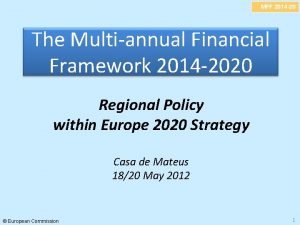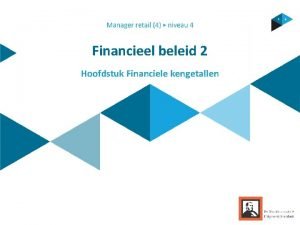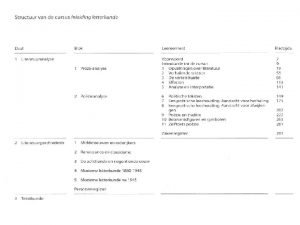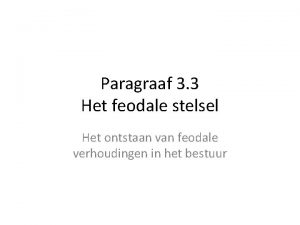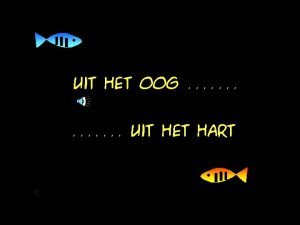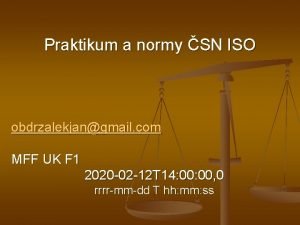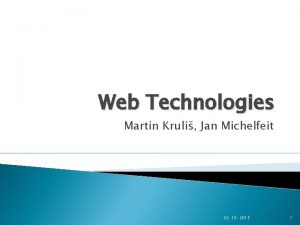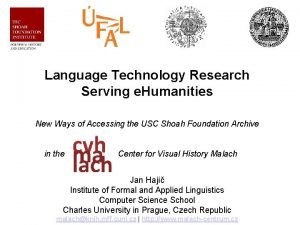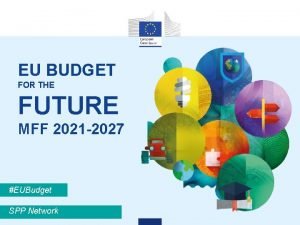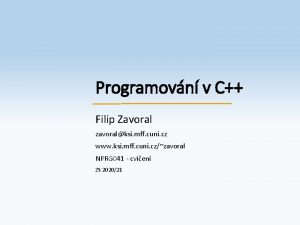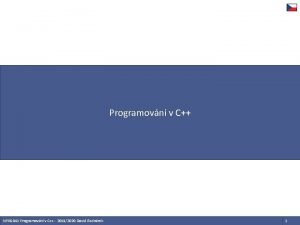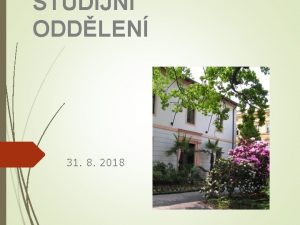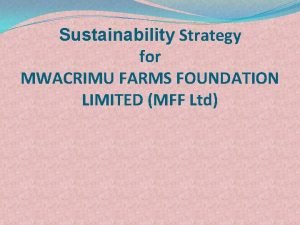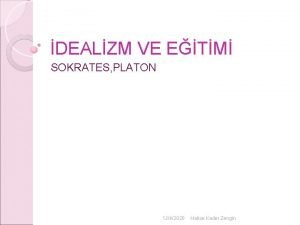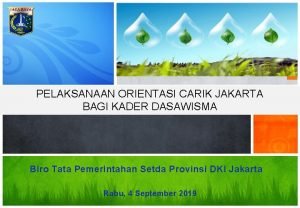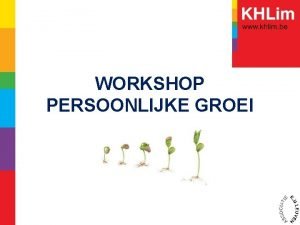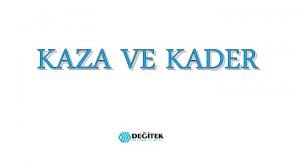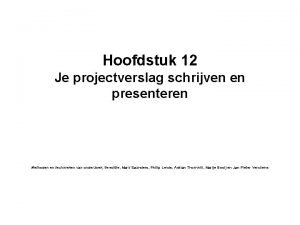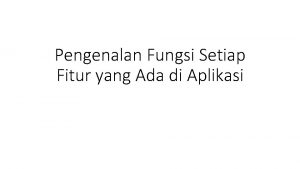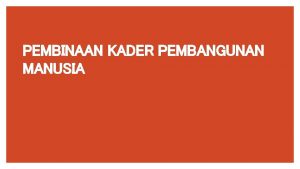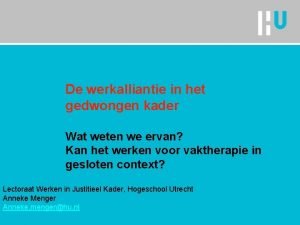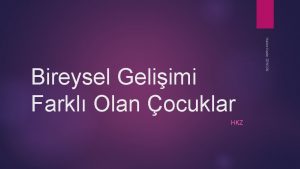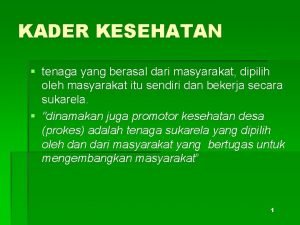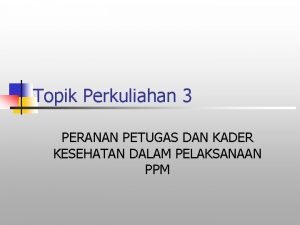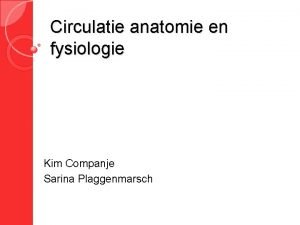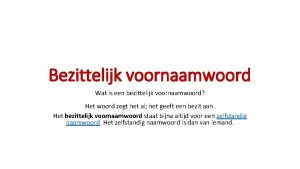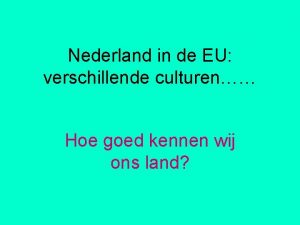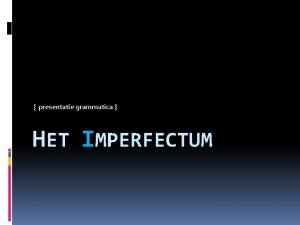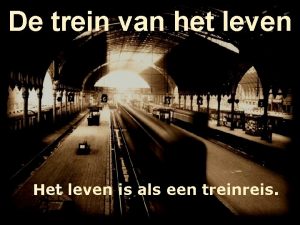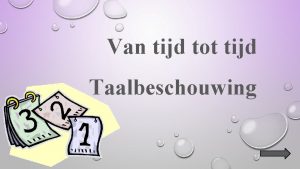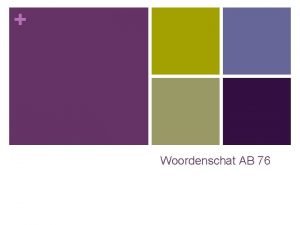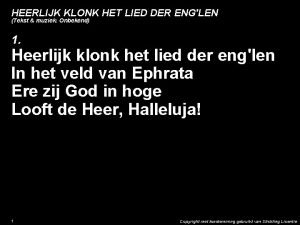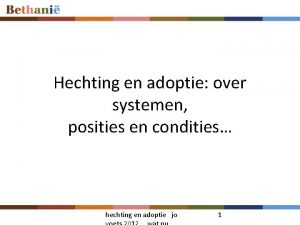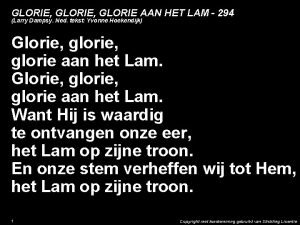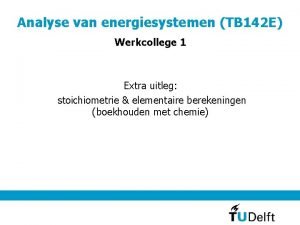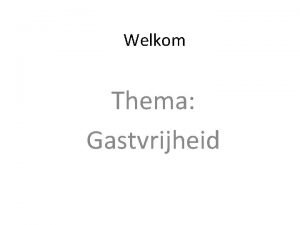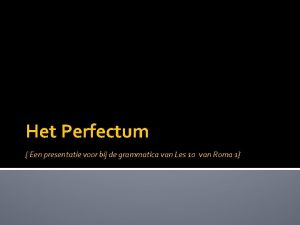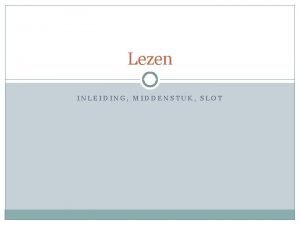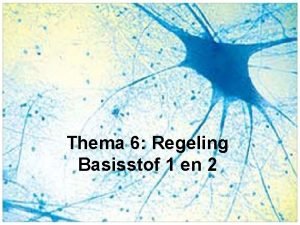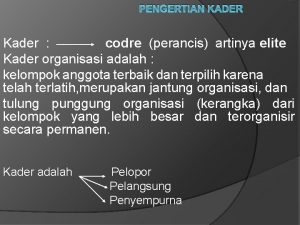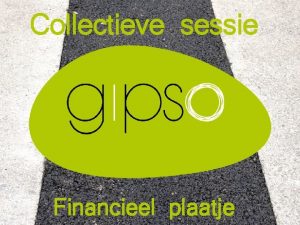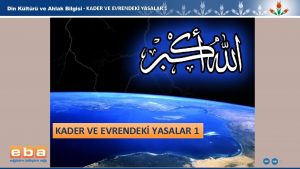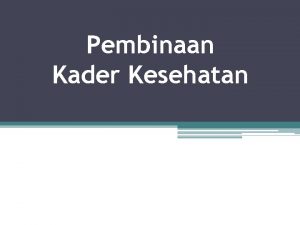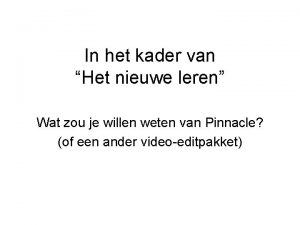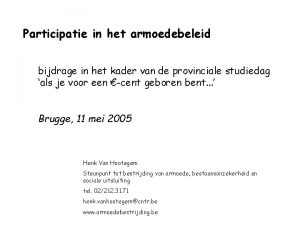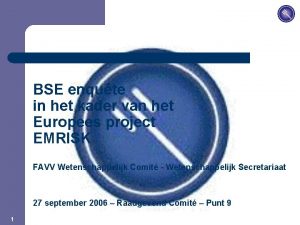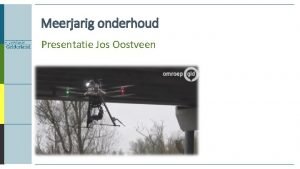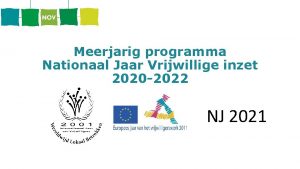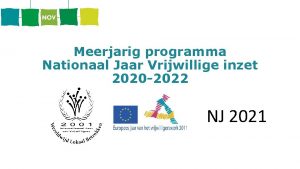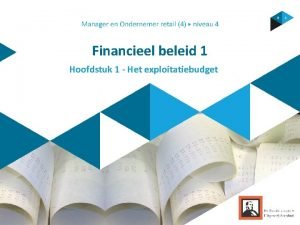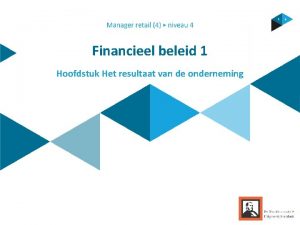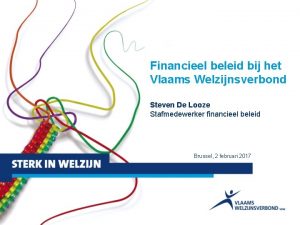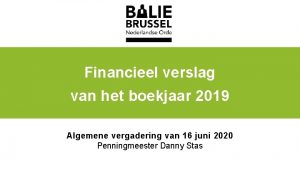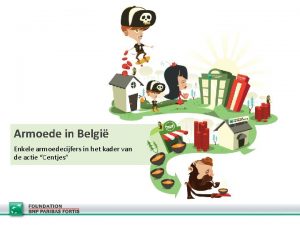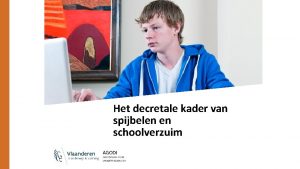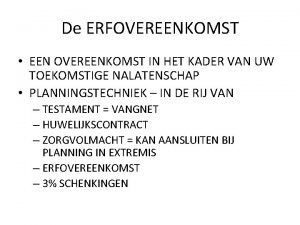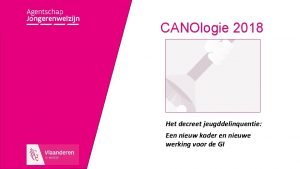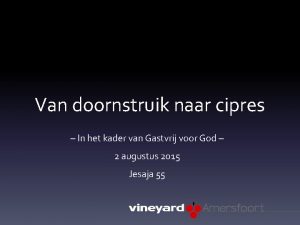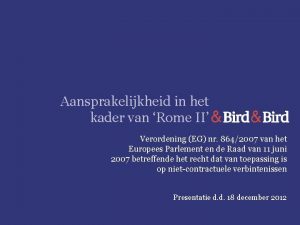MFF 2014 20 Het Meerjarig Financieel Kader 2014















![MFF 2014 -20 Overzicht presentatie 1. Totaalvolume 2. Uitgavenzijde 3. [Eigen middelen en correcties] MFF 2014 -20 Overzicht presentatie 1. Totaalvolume 2. Uitgavenzijde 3. [Eigen middelen en correcties]](https://slidetodoc.com/presentation_image/392fe3d49a082ae759dff147e7f532ed/image-16.jpg)



































- Slides: 51

MFF 2014 -20 Het Meerjarig Financieel Kader 2014 -2020 Een budget voor Europa 2020 © European Commission 1

MFF 2014 -20 MFK • I. Het oorspronkelijke voorstel van de COM • II. De huidige stand van zaken • III. Van speciaal belang voor onderwijs/onderzoek © European Commission 2

MFF 2014 -20 EU Budget = beleid in getallen Uitdagingen • • Lisbon Treaty : more responsibilities Connect Europe better Social, economic disparities Unstable neighborhood Austerity climate Financial crisis interventions Response to natural disasters Ensure synergies to prove EU Valueadded Meer EUROPA voor evenveel GELD! © European Commission Antwoorden • • European logic fully geared to Europe 2020 strategy Modernised budget - output oriented, simplification, conditionality, leveraging investment • Limited in size, but redesigned - savings in some areas - more to areas that matter - multi-purpose expenditure • Budgetary rigour, administrative limits • New legitimacy of traditional policies 3

MFF 2014 -20 Meer moderne begroting • Connecting Europe Facility • Innovative financial instruments • Key changes in research, cohesion, agriculture and external action • Administrative rigour • Simplification • New Own resources • Simplified system of corrections © European Commission 4

MFF 2014 -20 I. Voorstel COM: overzicht 1. Totaal volume 2. Uitgaven - overzicht 3. [Eigen middelen en correcties] © European Commission 5

MFF 2014 -20 Vastleggingen versus betalingskredieten Commitments Payments MFF + Outside MFF © European Commission € 1025 Billion € 972 Billion € 1083 Billion 1, 05% BNI 1, 00% of GNI 1, 11 % Of GNI 6

MFF 2014 -20 Buiten het Meerjaren Financieel Kader © European Commission 7

MFF 2014 -20 Overzicht voorstelling 1. Totaal volume 2. Overzicht uitgavenzijde 3. [Eigen middelen en correcties] © European Commission 8

MFF 2014 -20 Ambitieus, maar realistisch… © European Commission 9

MFF 2014 -20 Beduidende herverdeling in sleutelsectoren beleid © European Commission 10

MFF 2014 -20 Ontwikkeling GLB en Cohesie in 2013 -2020 © European Commission 11

MFF 2014 -20 Cohesie Niewe architectuur cohesiebeleid • Three categories of regions – Less developed regions (GDP per capita < 75%) – Transition regions (GDP per capita between 75% and 90%) – More developed regions (GDP per capita > 90%) – • Cohesion Fund for Member States with GNI per capita <90% Territorial cooperation (3 strands: CBC, transnational, interregional) © European Commission 12

MFF 2014 -20 Cohesion policy • Common strategic framework for all structural funds • Investment partnership contracts with Member States • Stronger conditionality • The biggest spending area by 2020 • Concentration on poorer and weakest regions • Thematic concentration • Transition regions © European Commission 13

MFF 2014 -20 Landbouw • Declining share in the EU budget until 2020 • Greening of CAP - direct aid 30 % linked to environment measures • Progressive convergence towards EU average: – Close 33% of the gap with 90% of EU average – Financed by all Member States above the average • Market measures: Emergency Mechanism • European Globalisation Fund to help farmers adapt to globalisation © European Commission 14

MFF 2014 -20 Administratieve uitgaven • Budget under restraint – Staff reduction up to 5% – Efficiency gains (increase working hours to 40 a week) – Reviewing certain benefits in line with similar trends in Member States • Administrative expenditure discipline for all EU institutions * Excluding Pensions and European Schools © European Commission 15
![MFF 2014 20 Overzicht presentatie 1 Totaalvolume 2 Uitgavenzijde 3 Eigen middelen en correcties MFF 2014 -20 Overzicht presentatie 1. Totaalvolume 2. Uitgavenzijde 3. [Eigen middelen en correcties]](https://slidetodoc.com/presentation_image/392fe3d49a082ae759dff147e7f532ed/image-16.jpg)
MFF 2014 -20 Overzicht presentatie 1. Totaalvolume 2. Uitgavenzijde 3. [Eigen middelen en correcties] © European Commission 16

MFF 2014 -20 II. Huidige situatie • Manier van werken: 1. Raadswerkgroep SA en FOP; bilaterales met kabinet Van Rompuy 2. Coreper – RAZ – Europese Raad - Trilaterales © European Commission 17

MFF 2014 -20 II. Huidige situatie (b) 2. Stavaza 1 november 2012: naar Europese Raad op 22 -23/11 * Kloof tussen netto-betalers (DU, NL, FI, …) en netto-ontvangers (nieuwe lidstaten, lidstaten in serieuze fin. -econ. Problemen) * BE: in tussenpositie … * Cyprioten zetten cijfers in “onderhandelingsdoos” MFK © European Commission 18

MFF 2014 -20 II. Huidige situatie (c) • Grote spanningen rond: • Algemeen volume begroting: - 100 miljard euro? (Voorstel CY: op dit ogenblik in totaal: - 50 miljard: “tussensituatie naar extra bezuinigingen”; wellicht naar – 50 tot – 75 miljard euro • Geld voor cohesie: transitieregio’s, competiviteitsregio’s, macroeconomische conditionaliteit? Allocatiecriteria competregio’s … • Geld voor GLB: daling pijler 1 (art. 53)? Convergentie tussen oude en nieuwere LS: snelheid? Pijler 2 voor wie? Vergroening … • Food for deprived (2 miljard) naar ESF • Connecting Europe Facility: - 30 % t. a. v. voorstel COM voor Transport, - 23 % Energie, - 24 % ICT © European Commission 19

MFF 2014 -20 II. Huidige situatie (d) • Rubriek 1 a: Competiviteit: - 11 % (SIC); maar toch nog 61, 3 % t. a. v. vorige periode • Wat met ITER, GMES: in 1 a zonder compensatie? • 1 b: (Cohesie): - 4 % - vooral meest ontwikkelde - en transitieregio’s © European Commission 20

MFF 2014 -20 III. Belangrijk voor hoger onderwijs a) Horizon 2020: onderzoeksprogramma b) Erasmus for All © European Commission 21

MFF 2014 -20 Proposal for the EU Framework Programme for Research and Innovation (2014 -2020) DG Research & Innovation, European Commission © European Commission

MFF 2014 -20 Impact of R&D on economic recovery © European Commission

MFF 2014 -20 Context • Economic context: • Priority for growth enhancing measures within smart fiscal consolidation • R&I essential for competitiveness and creating and retaining high value jobs and industries • Policy context: • R&I central to Europe 2020 strategy and to realise EU goals in areas such as energy, environment, transport, security • International context: • EU falling behind other regions in R&D (e. g. US, Japan) and losing ground to emerging countries (e. g. China, India) © European Commission

MFF 2014 -20 Added value of R&I spending at EU level • Cross-border pooling of resources achieves critical mass and diffusion of knowledge • EU level competition increases levels of R&I excellence and international attractiveness for global talent • Cross-border training and career development enhances Europe’s research and innovation capacities • EU projects provide knowledge to address pan-European policy challenges and advance Single Market • Partnerships with Member States increases efficiency and effectiveness of public spending (e. g. removes duplications) • Risk sharing with private sector, leverages additional private R&I investments © European Commission

MFF 2014 -20 Some examples: • EU collaborative research on 3 G mobile phone standards, led to € 250 billion market revenues for EU companies. • EU Risk Sharing Finance Facility has leveraged investments in R&D (EIB, private sector) worth 30 times EU contribution. • European Research Council grants are attracting leading researchers from US (in some fields more than half of grant holders have doctorates/ post docs in US) • Evaluations show every € 1 of EU R&D spending leads to an increase in industry added value of € 7 -14. © European Commission

MFF 2014 -20 Horizon 2020: general objective • General objective: building an economy based on knowledge and innovation; supporting Europe 2020 and European Research Area. • Proposed budget 2014 -20: € 77. 606 billion (constant 2011 prices) – Also € 1. 665 billion Euratom 2014 -18; € 0. 729 provisioned for 2019 -20 • Performance indicators: Europe 2020 R&D target (3% of GDP, currently 2. 01%); Europe 2020 innovation indicator © European Commission

MFF 2014 -20 Horizon 2020: specific objectives (1) Priority 1 – Excellent Science European Research Council 13 268 Frontier research by the best individual teams Future and Emerging Technologies 3 100 Collaborative research to open new fields of innovation Marie Curie actions 5 572 Opportunities for training and career development Research infrastructures (including e-infrastructure) Ensuring access to world-class facilities © European Commission 2 478

MFF 2014 -20 Horizon 2020: specific objectives (2) Priority 2 – Industrial Leadership in enabling & industrial technologies 13 781 (ICT, nanotech, materials, biotech, manufacturing, space) Access to risk finance 3 538 Leveraging private finance and venture capital Innovation in SMEs Fostering all forms of innovation in all types of SMEs © European Commission 619

MFF 2014 -20 Horizon 2020: specific objectives (3) Priority 3 – Societal Challenges Health, demographic change and wellbeing 8 033 Food security, sustainable agriculture, marine and maritime research & the bioeconomy 4 152 Secure, clean and efficient energy* 5 782 Smart, green and integrated transport Climate action, resource efficiency and raw materials Inclusive, innovative and secure societies 6 802 3 160 3 819 *Additional € 1 788 m for nuclear safety and security from the Euratom Treaty activities (2014 -18). Does not include ITER. © European Commission

MFF 2014 -20 Horizon 2020: specific objectives (4) supported by: Three priorities also European Institute of Innovation & Technology (EIT) Combining research, innovation & training in Knowledge and Innovation Communities Joint Research Centre (JRC)** 1 360 + 1 440* 1 962 Providing a robust, evidence base for EU policies * Second tranche pro rata from Enabling & Industrial Technologies and Societal challenges (subject to review) **Additional € 656 m for the JRC to be funded from the Euratom Treaty activities © European Commission

MFF 2014 -20 Major simplification • Single framework programme integrating 3 separate instruments (and 8 different specific programmes) • Single set of rules covering all R&I funding, aligned with Financial Regulations • One project, one funding rate – 100% direct costs*, 20% flat rate for indirect costs • Fewer, better targeted, controls & audits • Faster time to grant – average time reduced by 100 days • Efficient management, including greater use of external management • * Lower maximum rate (70%) for closer to market projects. Projects will require cofunding by participants for indirect costs which are typically in the order of 100% of direct costs. © European Commission

MFF 2014 -20 Synergies with Cohesion policy • – – – Clear division of labour: Horizon 2020 = excellence through open, EU wide competitions Cohesion policy = building regional research and innovation capacity Horizon 2020: Simplification to ensure equal access for all Targeted measures for less developed regions to improve policy learning, support international networking, and attract talent Cohesion Policy: Research and innovation as an investment priority R&I operational programmes conditional on smart specialisation strategy Inter-regional cooperation to includes cooperation between clusters, researchers and research institutions, based on FP 7 ‘Regions of Knowledge’ and ‘Research potential’ © European Commission

MFF 2014 -20 Synergies with the Competitiveness and SME programme (COSME) • Horizon 2020 and COSME are complementary programmes to generate growth and jobs: – – Horizon 2020 = innovation driven growth COSME = support to create favourable business environment and competitiveness • Which will be closely coordinated, e. g: – – © European Commission Financial instruments (debt and equity): clear criteria to decide which programme provides EU contribution SME support: Enterprise Europe Network under COSME, to act as ‘one stop shop’ for EU funding

MFF 2014 -20 « ERASMUS FOR ALL » A Single Programme for Education, Training, Youth and Sport (2014 -2020) 35 © European Commission

The context and rationale of the MFF 2014 -2020 MFF 2014 -20 • Concentration of efforts on Europe 2020: objectives and strategic priorities • Focus on EU added value: pooling of resources; from a culture of entitlement to a culture of results, incentives, partnerships and evaluation of impact • Simplification: streamlined legal basis and programmes, simpler rules and innovative financing sources to enhance the leverage of the EU budget 36 © European Commission

MFF 2014 -20 The context and rationale of Erasmus for All • Key role: to enhance the contribution of education and human capital to sustainable growth. Hence the rationale: ► Concentration of efforts on the education aspects of Europe 2020 through the policy frameworks of ET 2020 and the Youth strategy, and through policy development; ► Focus on EU added value through mobility, cooperation and policy reform to promote the modernisation of education systems at all levels and address skills shortages and mismatches; ► Simplification via streamlining of legal bases into a single programme, simpler rules and innovative funding sources. 37 © European Commission

MFF 2014 -20 A Streamlined architecture Existing programmes Lifelong Learning Programme International higher education programmes: Erasmus Mundus, Tempus, Alfa, Edulink, Bilateral Programmes Grundtvig Erasmus for All 1. Learning Mobility Erasmus Leonardo Comenius A single integrated programme 3. 2. Co-operation Policy Support projects Youth in Action Programme Specific activities: • Jean Monnet • Sport 38 © European Commission

MFF 2014 -20 3 Key actions Key action 1: Learning mobility of individuals Key action 2: Co-operation for innovation and good practices Key action 3: Support for policy reform 39 © European Commission

MFF 2014 -20 Learning Mobility • Modernising education through chances to learn abroad: ►Students: higher education and vocational training ►Masters students: a new loan guarantee mechanism ►Youth: international volunteering and youth exchanges ►Staff: teachers, trainers, school leaders and youth workers ►International dimension: mobility for EU and non-EU beneficiaries 40 © European Commission

MFF 2014 -20 Erasmus Master- Loan Guarantee scheme • Why? – No support for degree mobility at master level – National grants/loans often not portable – More inclusive access to mobility – Leverage effect of EU budget • Who? – Managed by the European Investment Fund (EIF) • Eligibility? – Students who wish to study a full Masters degree in another participating country – Average of 47. 000 loans a year • How? – EU Budget provides part guarantee against non-repayment – technicalities dealt within the debt platform and in cooperation with EIF, ECFIN and BUDG – In return, banks/student loan agencies must agree to offer favourable terms (interest rates, repayment terms, grace periods etc. ) 41 © European Commission

MFF 2014 -20 Cooperation for innovation • Modernising education through cooperation: ► Partnerships between education institutions, youth organisations, training institutions and other actors ► Large-scale cooperation between education and business: ‘Knowledge Alliances’ and ‘sector Skills Alliances’ ► Connecting students and staff via web platforms ► Helping modernisation of universities in third countries 42 © European Commission

MFF 2014 -20 Support for policy reform • Modernising education through policy support: ► Evidence based support for effective education investment ► Development and promotion of EU wide tools to assess and recognise skills ► Peer learning and cross-fertilization between education systems 43 © European Commission

MFF 2014 -20 International Dimension Objective (MMF Communication): incorporate all existing international programmes (Erasmus Mundus, Tempus, Alfa, and Edulink) to: (1) put an end to the current fragmentation; (2) enhance the global visibility and impact and (3) increase efficiency. 1. International opening of Erasmus: more mobility of students and staff between EU – non EU in both directions 2. Joint Master courses of high quality offered by consortium of EU/non EU universities to attract the very best students worldwide 3. Specific support with neighbourhood countries: More cooperation between universities for capacity building and more student and staff mobility, in line with development objectives 4. Rest of the world: More cooperation between universities in the EU and rest of the world for capacity building, in line with development objectives 44 © European Commission

MFF 2014 -20 Jean Monnet • Erasmus for all will Include support for teaching and research on European integration via Jean Monnet activities Ø We maintain the Institutional support for College of Europe (Bruges and Natolin) and the European Institute of Florence Ø We open a competitive support to other institutions based on excellence and added value Ø The Jean Monnet Chair continues to be a key component Ø We propose the creation of the Jean Monnet Label of Excellence 45 © European Commission

MFF 2014 -20 Sport • Erasmus for all will Support the European dimension of Sport Ø Focus on grassroots sport activities (not the top professional level) Ø Tackle transnational threats to sport (amateur doping, match-fixing, violence, racism, intolerance) Ø Develop European Cooperation in sport (improving good governance, promoting dual careers for athletes Ø Social inclusion in sport and health enhancement 46 © European Commission

MFF 2014 -20 Budget BUDGET ALLOCATION BY TYPE OF ACTION FOR THE PROGRAMME 47 © European Commission

MFF 2014 -20 Budget Indicative allocations expressed in percentage: Ø 25 % for higher education; Ø 17 % for vocational education and training and adult learning (of which 2 % for adult learning); Ø 7 % for schools; Ø 7 % for youth 48 © European Commission

MFF 2014 -20 Budget implementation architecture Management by National Agencies: 12, 7 billion € (65%) –Learning mobility of individuals (excluding joint/double degree) also for the international dimension –Cooperation for innovation and good practices: Strategic partnerships between education institutions or between youth organisations and/or relevant actors Centralised management by Executive Agency : 6, 8 billion € (35%) – Learning mobility of HE students in joint/double degree – Cooperation for innovation and good practices: Knowledge alliances, Sector Skills alliances, Capacity building in third countries, IT support platforms – Support to policy reform: Support to open method of coordination, EU transparency tools, Policy dialogue Centralised management by EC : Residual 49 © European Commission

MFF 2014 -20 Management system • • 2007 -2013 EC sets management rules MS designates National Agency MS issues ex-ante declaration of assurance on National Agency MS delivers yearly declaration of assurance on National Agency compliance and accounts MS in charge of audits and control of National Agency Good results but heavy and continuous workload on MS Difficult match with timing requirements for Annual Activity Report • • 2014 -2020 EC sets management rules MS designates National Agency and independent audit body MS issues ex-ante compliance assurance on National Agency provides yearly management declaration of assurance with independent audit report MS supervises national system and informs EC High assurance level kept, but with less burden for MS In tune with timing requirements for Annual Activity Report 50 © European Commission

MFF 2014 -20 Estimated output figures • Up to 5 million people overall will benefit from mobility opportunities during 2014 -2020 (versus 2. 8 million in 2007 -2013) ; • Over 2 200 000 higher education students and 730 000 vocational students will spend a part of their education abroad, including about 700 000 traineeships in companies ; • Nearly 1 million teachers, trainers, education staff and youth workers will acquire new teaching and learning methods abroad ; • 330 000 Master students will benefit from the new loan guarantee scheme ; • 540 000 young people will be given the opportunity to volunteer or participate in youth exchanges ; • 34 000 joint degree students (between EU and non-EU universities) ; • Over 20 000 Strategic Partnerships involving 115 000 institutions / organisations ; • 400 Knowledge and Sector skills Alliances involving 4000 education institutions. 51 © European Commission
 Mff 2014-20
Mff 2014-20 Hefboomeffect rentabiliteit
Hefboomeffect rentabiliteit Regenead
Regenead Heupbeen walvis
Heupbeen walvis Wat is de functie van weefselvloeistof
Wat is de functie van weefselvloeistof Het ontstaan van feodale verhoudingen in het bestuur
Het ontstaan van feodale verhoudingen in het bestuur Smoet vet espe en spek
Smoet vet espe en spek Martine maan
Martine maan Het leven praktische lessen uit het boek
Het leven praktische lessen uit het boek Mff praktikum
Mff praktikum Pavel mff
Pavel mff Martin michelfeit
Martin michelfeit Shoah
Shoah Eu budget for the future
Eu budget for the future Recodex gchd
Recodex gchd Gitlab mff
Gitlab mff Mff studijni oddeleni
Mff studijni oddeleni Hric mff
Hric mff Mff international pte ltd
Mff international pte ltd Kader
Kader Halise kader zengin
Halise kader zengin Kwaliteitsdecreet onderwijs
Kwaliteitsdecreet onderwijs Orientasi carik jakarta kader dasawisma
Orientasi carik jakarta kader dasawisma Kader i
Kader i 8.sınıf din kültürü fiziksel yasalara örnekler
8.sınıf din kültürü fiziksel yasalara örnekler Kader
Kader Cara cetak id kader dasawisma
Cara cetak id kader dasawisma Tugas kader kpm
Tugas kader kpm Werkalliantie betekenis
Werkalliantie betekenis Halise kader zengin
Halise kader zengin Tugas kader posyandu lansia
Tugas kader posyandu lansia Syarat menjadi kader kesehatan
Syarat menjadi kader kesehatan Bouw van het hart
Bouw van het hart Verkorte bezittelijke voornaamwoorden
Verkorte bezittelijke voornaamwoorden Alta marincowitz information
Alta marincowitz information Hoeveel coupletten heeft het wilhelmus
Hoeveel coupletten heeft het wilhelmus Imperfectum grieks
Imperfectum grieks De trein van het leven
De trein van het leven De of het wiel
De of het wiel 76 in het frans
76 in het frans Tekst heerlijk klonk het lied der engelen
Tekst heerlijk klonk het lied der engelen Model van belsky
Model van belsky Glorie aan het lam tekst
Glorie aan het lam tekst Het merk ik
Het merk ik Atoomnr 33
Atoomnr 33 Het volk dat in duisternis wandelt zal een groot licht zien
Het volk dat in duisternis wandelt zal een groot licht zien Opwekking 464
Opwekking 464 Vzv grammatica
Vzv grammatica Perfectum uitgangen
Perfectum uitgangen Aan de maaltijd wordt het stil
Aan de maaltijd wordt het stil Wat staat er meestal in het middenstuk van een tekst
Wat staat er meestal in het middenstuk van een tekst Zenuwcel onderdelen
Zenuwcel onderdelen
